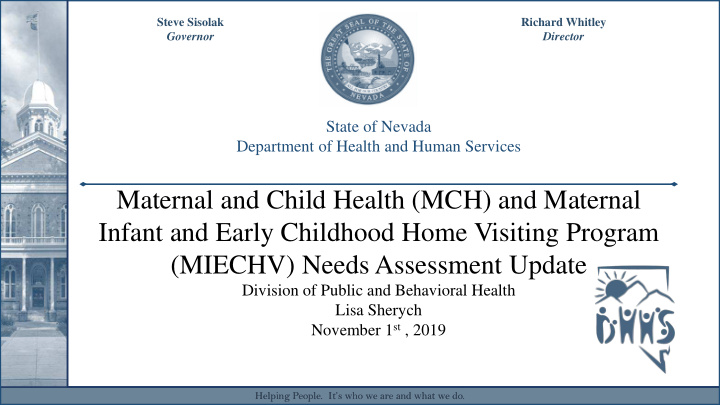



Steve Sisolak Richard Whitley Governor Director State of Nevada Department of Health and Human Services Maternal and Child Health (MCH) and Maternal Infant and Early Childhood Home Visiting Program (MIECHV) Needs Assessment Update Division of Public and Behavioral Health Lisa Sherych November 1 st , 2019 Helping People. It’s who we are and what we do. Helping People. It’s who we are and what we do.
MCH and MIECHV Needs Assessment Update Tami Conn Melissa Madera SSDI/MCH Health Program Data Analyst Specialist II Nevada Home Visiting Program Maternal Child and Adolescent mmadera@health.nv.gov Health (MCAH) tconn@health.nv.gov Helping People. It’s who we are and what we do. 2
Need eds s Assess sessmen ent r requirem emen ent f for M MCH a and nd MIECHV • Maternal and Child Health (MCH) • Required by HRSA for Title V Block Grant (TVGB) – Due July 2020 • Target populations: women of childbearing age, pregnant women, children and adolescents, children and youth with special health care needs (CYSHCN) and infants • A requirement of the MCH TVBG is to conduct a community needs assessment every 5 years and submit with grant application • Maternal Infant and Early Childhood Home Visiting Program (MIECHV) • 5-year comprehensive needs assessment required by MIECHV Grant – Due October 2020 • Target populations: Pregnant women and families with young children, particularly those considered at-risk • Nevada Home Visiting (NHV) has received supplemental funding and guidance to conduct statewide community needs assessment Timeframe for completion MIECHV 20 months (September 2020) TVBG 17 months (July 2020) Helping People. It’s who we are and what we do. 3
State M MCH Block Grant N Needs A Assessment, Pl Planni nning, I Implementation a and nd Monitoring ing P Process Currently, staff are working with contractor to gather qualitative information and analyze quantitative information to assess the population’s needs. Helping People. It’s who we are and what we do.
MI MIECHV Simplified Me Method • Four Nevada counties were identified as having families with children at risk: Clark, Mineral, Nye, and Washoe counties • Identified by using raw county level data from federal government sources • The federal program selected indicators to align with statue definition of at-risk communities • An algorithm is used to determine a county as at-risk Helping People. It’s who we are and what we do. 5
Simplified + + Me Method • MIECHV needs assessment guidance allows flexibility for grantees to express the unique needs of the state • Additional indicators and domains needed to identify risks • Additional data sets and information to justify identified risks • NHV aims to expand the findings of the data summary • Using state, county, sub-county and sub-population data sets available through the Office of Analytics, University of Nevada, Reno and other entities • Collecting information from interviews, focus groups, and surveying • Supplement federal multivariate at-risk data Helping People. It’s who we are and what we do. 6
Timeline Helping People. It’s who we are and what we do. 7
Ne Need eds A Assessmen ent P Proj ojec ect Status • Completed tasks • Created key informant interview (KII) guides • Created focus group guide • 12 key informant interviews have been completed • 2 focus groups completed • Survey has been drafted and final approvals are in process • Data analysis of pre-existing data is in process Helping People. It’s who we are and what we do. 8
Ne Need eds Assessmen ent Proj ojec ect Status ( (Con ont.) • Continue conducting focus groups • Continue conducting Key Informant Interviews (KII) • Roll out provider and public survey • Continue to analyze quantitative data • Analyze qualitative data after focus groups, KIIs and survey are complete Helping People. It’s who we are and what we do. 9
Thank y you, Melissa Madera Tami Conn Data Analyst, Nevada Home Visiting Program SSDI/MCH Health Program Specialist II Office of Analytics, Director’s Office Maternal, Child and Adolescent Health Section Department of Health and Human Services Nevada Division of Public and Behavioral Health mmadera@health.nv.gov tconn@health.nv.gov Helping People. It’s who we are and what we do. 10
Recommend
More recommend